A woman is involuntarily committed to a mental institution where she is confronted by her greatest fear.
Unsane (2018), directed by Steven Soderbergh, is a psychological thriller that delves into themes of mental health, trauma, and the fine line between reality and perception. The film follows Sawyer Valentini (Claire Foy), a woman who relocates to a new city to escape her persistent stalker, David Strine (Joshua Leonard). Despite her efforts, Sawyer remains haunted by her past, leading her to seek therapy at Highland Creek Behavioral Center. Unbeknownst to her, she inadvertently signs herself into a 24-hour psychiatric hold. As she navigates the facility, Sawyer encounters unsettling situations, including the discovery that David is working there under an alias. The narrative blurs the lines between reality and delusion, leaving both Sawyer and the audience questioning what is real.
Main Themes
- Mental Health and Institutionalization
The film explores the complexities of mental health, highlighting the challenges individuals face when seeking help and the potential for exploitation within psychiatric institutions. Sawyer’s journey underscores the stigma and misunderstandings surrounding mental illness.
- Perception vs. Reality
Unsane masterfully plays with the concept of perception, questioning the reliability of the protagonist’s experiences and the audience’s understanding of the narrative. This theme is central to the film’s suspense and psychological tension.
- Surveillance and Privacy
The film touches on the pervasive nature of surveillance in modern society, emphasizing the loss of privacy and the potential dangers of constant monitoring. Sawyer’s experiences reflect broader societal concerns about personal security and autonomy.
- Gender and Power Dynamics
Unsane subtly critiques societal attitudes towards women, particularly in the context of mental health. Sawyer’s struggles highlight how women are often disbelieved and silenced, reflecting broader issues of gender inequality.
- Trust and Betrayal
The film delves into themes of trust, particularly the betrayal of personal safety and well-being. Sawyer’s experiences in the psychiatric facility challenge her ability to trust those around her, including medical professionals and fellow patients.
Impact of the Movie
Upon its release, Unsane received mixed reviews. Critics praised Claire Foy’s compelling performance and Soderbergh’s innovative use of iPhone cinematography, which added a raw, immersive quality to the film. However, some critics felt that the film’s narrative became implausible in its third act, detracting from its overall impact. Despite these critiques, Unsane sparked discussions about the portrayal of mental health in cinema and the ethical considerations of psychiatric institutions.
7 Reasons to Watch Unsane (2018)
- Innovative Cinematography
Steven Soderbergh’s decision to shoot Unsane entirely on an iPhone 7 adds a unique, gritty aesthetic to the film. This unconventional approach enhances the sense of immediacy and intimacy, drawing viewers deeper into Sawyer’s harrowing experience.
- Compelling Performance by Claire Foy
Claire Foy delivers a standout performance as Sawyer, capturing the character’s vulnerability, strength, and determination. Her portrayal adds depth to the narrative, making Sawyer’s journey both relatable and emotionally resonant.
- Psychological Depth
Unsane offers a nuanced exploration of mental health, delving into the complexities of trauma and the fine line between reality and delusion. The film encourages viewers to question their perceptions and consider the reliability of their own experiences.
- Thrilling Suspense
The film maintains a high level of suspense throughout, with unexpected twists and turns that keep viewers on the edge of their seats. The tension is palpable, making it a gripping watch for fans of psychological thrillers.
- Social Commentary
Unsane provides a critical look at the healthcare system, particularly the ethics of psychiatric institutions. It raises important questions about patient rights, the potential for abuse, and the commercialization of mental health services.
- Atmospheric Direction
Soderbergh’s direction creates a claustrophobic and unsettling atmosphere, effectively conveying the protagonist’s sense of entrapment and paranoia. The film’s pacing and visual style immerse viewers in Sawyer’s psychological turmoil.
- Thought-Provoking Themes
The film tackles complex themes such as surveillance, privacy, and gender dynamics, prompting viewers to reflect on societal issues and their implications. It encourages critical thinking and discussion long after the credits roll.
How Will You Feel After Watching Unsane (2018) ?
After watching Unsane, you may experience a range of emotions, from unease to introspection. The film’s intense portrayal of psychological distress and the blurring of reality and delusion can leave you questioning the nature of perception and the reliability of your own experiences. The suspenseful narrative and unexpected twists may evoke feelings of tension and anxiety, as you navigate the protagonist’s harrowing journey. Additionally, the film’s exploration of societal issues related to mental health and privacy may prompt reflection on broader ethical considerations. Overall, Unsane offers a thought-provoking and emotionally charged experience that lingers after the viewing.

